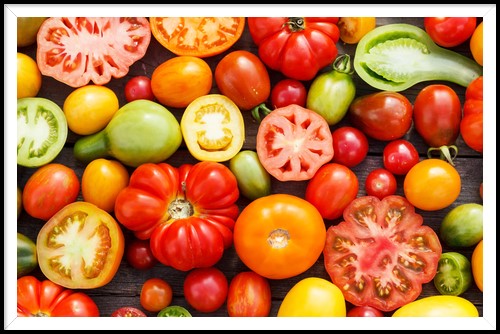About Our Veggies

You Can Never Have Enough Vegetables
Tomatoes, Peppers, Cucumbers & much more!
Here are some useful basics to keep in mind.
All of your Spring & Summer veggies want as much sun as possible!
To start: mix in a quality compost into your existing soil every season. Our Paydirt and Bumper Crop are ideal. You will also want to use some compost to add a 2 to 4 inch mulch layer on your soil surface once your planting is done to conserve moisture and inhibit weed competition. A good starter fertilizer like our EB Stone Organic Sure Start is beneficial for all new plantings as it's high phosphorous content aids in root growth. A quality organic vegetable fertilizer should also be used as the season continues for maximum production.
Tomato Tips
- Plant when the soil has warmed up and the nights aren't so chilly
- It is always best to cage your tomatoes as soon as you plant them, they grow very quickly and it will be hard to cage them later on
- Tomatoes are very heavy feeders, they need to be fed about every 3-4 weeks
- Tomatoes have a large root system and need large pots or garden beds, dwarf varieties are more readily available this year for smaller space
Cucumber Tips
- Plant when the season is warm and make sure they get plenty of full sun.
- Slow deep watering is recommended when soil begins to dry out.
- Fertilize soil for maximum nutrient content.
- Like pumpkins, cucumbers also do well when grown on mounds or up a trellis.
- Harvest often to maximize productivity.
Eggplants Aplenty
- Eggplants will require some support, especially for traditional large types. Japanese Eggplant do not need much if any support and lack the bitterness of traditional eggplant. You can use these fresh from the garden without a salt soak. Great for stir fries.
- Well-drained soil is extremely important.
- Can easily be grown in containers.
- Regular water, but remember they like well-drained soil.
- In addition to initial fertilization it is also useful to give them an extra boost as the season goes on.
Beans
Pole Beans- Require the support of a trellis or tomato cage. Continue producing as they are harvested.
Bush Beans- Easier than pole beans, bush beans require no support. Short season with a single harvest.
Let's Talk About Squash
Summer Squash- Popular varieties range from white to dark green and yellow, striped, solid, round, long, and disc shaped. There are different uses for different kinds of summer squash and it's best to plant several types if you love cooking and want variety in your dishes. Squash grows fast and it's best to harvest early and often for best taste and texture.
Variety types include Patty Pans, Zucchini, Yellow Crooknecks and Straightnecks.
Winter Squash -
This category includes Pumpkins, Butternut, Spaghetti
and Acorn Squash.
Winter squash stays on the vine for longer than summer squash and takes up a good amount of space. Plant in an area where they can sprawl.
A good way to tell if your winter squash is ripe is to give it a little thump to hear if it sounds hollow. If so, it is time to harvest.
Some Words on Pumpkins
You can't have a fall harvest without pumpkins and having your own pumpkin patch brings a smile to everyone's face, not just your kiddos! Think beyond the backyard. Planting a pumpkin patch in your front yard along with corn and sunflowers makes a beautiful eye catching display for everyone strolling by to enjoy all summer and at Halloween time!
- Plant early in the season but after frost when the soil is warm. May is ideal.
- Pumpkins have a long growing season and need lots of full sun.
- If possible grow on mounds for downward growth.
- Pumpkins are heavy feeders, so fertilizer is a must.
- Make sure soil drains enough to avoid rot from over-watering.
- For really large pumpkins, you will want to only allow one or two pumpkins grow per vine.
Greens
From Spinach to Lettuce to Kale, there are a wide variety of different kinds of greens with their own tastes.
- Plenty of light but don't let them get sunburned, especially as we head into the hotter months of summer, afternoon shade will be essential.
- Regular water.
- Make sure they have enough space to aerate to avoid mold.
- Greens are shallow rooted making window boxes ideal. Place near your back door for frequent baby green harvesting for your dinner salads!
Broccoli & Cauliflower
- There are many varieties of Broccoli & Cauliflower including but not limited to: Green Magic, Purple Sprouting, Romanesco, Snowball, Graffiti, & Cheddar
- Brassica family includes broccolis, cabbages, cauliflowers, mustards, & pak choy. The whole family requires full sun & rich, moist soil. Spacing depends on variety but a good general rule is 1-2 feet apart, giving the plants enough space and aeration is key to successful growth and lessens the possibility of mildew and disease.
Beets & Carrots
Like most root vegetables, beets and carrots love to be planted in deep, loose, well draining soils. These root vegetables thrive in cool seasons and can tolerate frost and even mature in cool weather.These crops can tolerate partial shade but do best in full sun (6-8 hours of sun)

